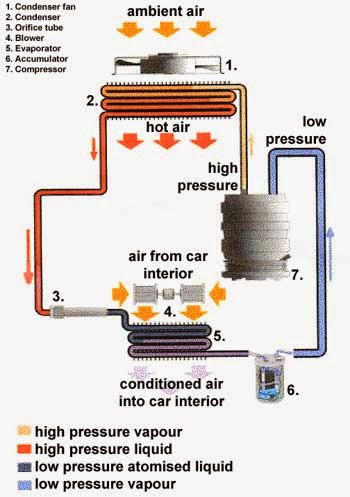Car AC working principle; Car Air conditioner
Air conditioning as names 'states' the conditioning of air. Air conditioner not only cools down the air , but also reduces humidity, or the moisture content. All air conditioners work exactly the same manner whether they're installed in a a vehicle, or in a building. Freezer or the refrigerator is an air conditioner too. Air conditioning is an area inside it's own right, but we'll adhere to the principal points or an automobile's air conditioning and the main parts used and a number of hints to keep the air-con system running properly.
There's energy used in removing moisture and the heat from the air in the automobile, and petrol is consumed by this because of the additional engine load.
The main principles of air conditioning are Evaporation and Condensation, then Compression and Expansion. To physicists and the engineer they talk of thermodynamics - but it 'll be explained by us in our own manner here:
Below is schematic diagram for explaining how actually air conditioner works;
Evaporation:
You might have noticed that if you rub a little surgical spirits on the back of the hand, then your hand will feel cold. It is evaporation. As the spirit evaporates, it takes away heat in the surface of your skin.
Condensation:
Maybe you have noticed when somebody walks in in the cold into a take away wearing spectacles, their glasses steam up? It's condensation.
Heat of Compression:
Perhaps you have noticed when you pump up a bike tyre with a hand pump, that the end of the pump gets hot? This is known as compression also you have noticed that in deodorants also liquid filled in bottle is compressed.
Compaction:
At some stage all gases will finally become liquid. An example of that will be a deodorant can - it is liquid (because you'll be able to hear it when you shake it) but is a gas when it hits your underarm and comes out. The pressure is higher, so the propellant interior is not gaseous.
Cooling by Expansion:
Going back to the deodorant, you'll notice also how cold it feels that is because the propellant has only grown in volume quickly.
Anyway, enough about surgical spirits and takeaways, armpits, but those are the fundamental ideas that are not difficult enough to clarify.
Flexible hoses and tough tubing connect all the real elements of the air conditioning in your auto. Evaporation and condensation, expansion and compaction are the physics of why it works.
The refrigerant then condense at a higher pressure, and can evaporate at a low temperature. In the bad old days, R-12 was the refrigerant used in practically all cars. It was broadly available, however it was discovered to be a subscriber to the hole in the ozone layer of the earth's as it was a chlorofluorocarbon (CFC).
Here is how all the various parts of a car's air conditioning works:
Compressor:
The compressor is the ac system, powered by a drive belt linked to the crankshaft of the engine's work horse. The compressor pumps refrigerant vapour under high pressure to the condenser, when the aircon system is turned on.
Condenser:
The condenser is a device used to change the high pressure refrigerant vapor to a liquid. It is mounted in front of the engine's radiator, and it looks much like a radiator. The vapour is condensed because of the high pressure that is driving it in, which generates a fantastic deal. The heat is in turn removed by air flowing through the condenser on the outside from the condenser.
Receiver:
The refrigerant that is now liquid moves to the receiver-dryer. It is a small reservoir vessel and removes any moisture that may have leaked into the refrigerant. Havoc is caused by moisture in the system, with ice crystals causing mechanical damage and blockages.
Expansion Valve:
The refrigerant that is pressurised flows in the receiver- drier to the expansion valve. The valve removes pressure from the liquid refrigerant so that it might expand and become refrigerant vapour in the evaporator. Air Conditioning
Evaporator:
The evaporator is another device that looks similar to an automobile radiator. It's tubes and fins and is normally mounted behind the fascia. The cold low-pressure refrigerant vaporizes and absorbs heat from the atmosphere in the passenger compartment, as it is passed into the evaporator. The blower fan pushes air over the evaporator's exterior , so chilly air is circulated inside the automobile. On the 'air-side' of the evaporator, the moisture in the air is reduced, and the 'condensate' is collected and drained away.
Compressor:
The compressor then draws in the low-pressure refrigerant vapor to begin another refrigeration cycle. The refrigeration cycle then runs constantly, and is regulated by the setting of the expansion valve.
The whole process is reasonably straightforward when described like this. All air conditioning systems work with the same principle, even if the precise parts used may vary slightly between car manufacturers.
Hopefully that clarifies a little as to how that small 'A/C' button works on your own automobile, if you want it clarified a little more in depth afterward if you roll up your sleeves we can demonstrate the parts in your car next time you bring it in for a check or service here at AirconCars.



Comments
Post a Comment